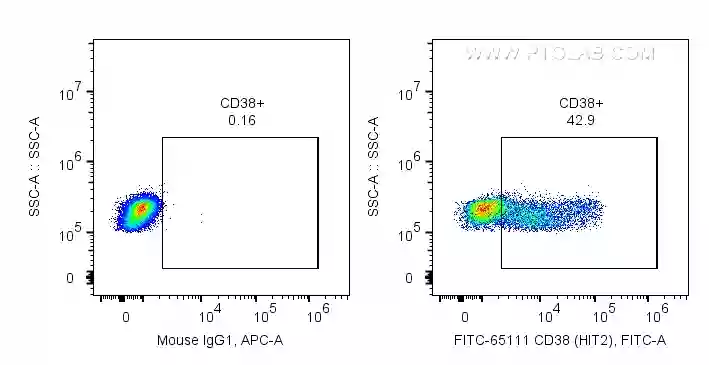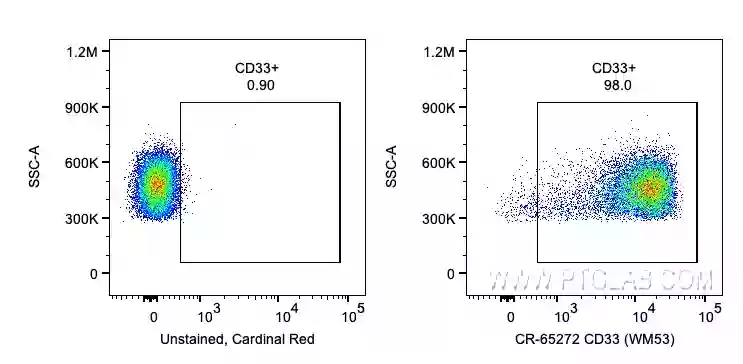Leukemia
Build out your next leukemia panel with Proteintech’s flow antibodies
Introduction
Leukemia is a cancer of the white blood cells. It is typically classified based on which cell lineage is affected and how quickly the cancer develops and grows. While bone marrow biopsies remain the gold standard in leukemia diagnosis, immunophenotyping with flow cytometry has quickly become a powerful method to further enhance leukemia classification as it is far more sensitive in detecting aberrant surface protein expression and cell lineage commitment. Proteintech’s flow antibody portfolio, conjugated to a wide range of traditional and super-bright, CoraLite® Plus dyes, is the perfect tool to help researchers better understand the distinct phenotypic signatures of leukemia. This information can in turn be utilized towards the development of more targeted therapies.
Types of Leukemia
Lymphoid
Lymphoid leukemias affect cells of the lymphocytic lineage, which include B cells, T cells, and NK cells. Of these, chronic lymphocytic leukemia (CLL) is the most common form of leukemia amongst adults, accounting for nearly 25% of all new leukemia cases. It is typically caused by acquired mutations that develop within lymphoid progenitor cells in the bone marrow. T and B cell markers such as CD2, CD3, CD4, CD5, CD7, CD8, CD19, and CD20 can be used to identify these mutated cells as they begin to rapidly proliferate. CD38 is often studied as a prognostic indicator of poor survival in both acute and chronic forms of this disease. It may also hold value as a future immunotherapy target.

Image Description: FC experiment of human PBMCs using FITC Plus Anti-Human CD38, clone HIT2 (FITC-65111). 1x106 human PBMCs were surface stained with 5 ul FITC-65111 or Mouse IgG1 isotype control. Cells were not fixed. Lymphocytes were gated.
Myeloid
Myeloid leukemia also arises in the bone marrow and commonly affects cells of myeloid lineage, such as granulocytes (neutrophils, basophils, eosinophils) and monocytes (macrophages). Acute myeloid leukemia (AML) is the more common form, typically occurring in older adults. Myeloid lineage markers can be used in the identification of these leukemia subtypes as their expression in the leukemic blasts is often altered in comparison to normal monocytic cells. For example, CD33, typically a marker for myeloid progenitors, remains highly expressed in AML as these cells do not undergo proper cell maturation. Additional markers such as CD14, CD16, CD64, and CD117 also show high sensitivity for the AML phenotype. Proteintech’s flow compatible CD33 antibody has been conjugated to 8 different colors, allowing for wide flexibility in panel construction.

Image Description: FC experiment of human PBMCs using Cardinal RedTM Anti-Human CD33, clone WM53 (CR-65272). 1x106 human PBMCs were surface stained with 5 ul of CR-65272 or left unstained. Cells were not fixed. Monocytes were gated.
Flow Antibodies for Lymphoid Leukemia Markers
| Target | Catalog | Clone | Reactivity | Pure | AB/ | FITC/ | PE/ | CR/ | APC/ | 750 |
| 405 | 488 | 555 | 594 | 674 | ||||||
| CD2 | 65192 | TS1/8 | Human | |||||||
| CD3 | 65077 | 17A2 | Mouse | |||||||
| 65112 | Hit3a | Human | ||||||||
| 65133 | OKT3 | Human | ||||||||
| 65148 | SK7 | Human | ||||||||
| 65151 | UCHT1 | Human | ||||||||
| 65060 | 145-2C11 | Mouse | ||||||||
| 65061 | 500-A2 | Mouse | ||||||||
| CD4 | 65104 | GK1.5 | Mouse | |||||||
| 65134 | OKT4 | Human | ||||||||
| 65141 | RM4-5 | Mouse | ||||||||
| 65143 | RPA-T4 | Human | ||||||||
| 65147 | SK3 | Human | ||||||||
| 65199 | RM4-4 | Mouse | ||||||||
| CD5 | 65152 | UCHT2 | Human | |||||||
| 65200 | L17F12 | Human | ||||||||
| CD7 | 65203 | 4H9 | Human | |||||||
| CD8 | 65146 | SK1 | Human | |||||||
| 65204 | UCHT4 | Human | ||||||||
| CD8α | 65069 | 53-6.7 | Mouse | |||||||
| 65113 | Hit8a | Human | ||||||||
| 65135 | OKT8 | Human | ||||||||
| 65144 | RPA-T8 | Human | ||||||||
| 65205 | 5H10-1 | Mouse | ||||||||
| CD10 | 60034 | 4B9D9 | Human | |||||||
| CD11c | 65086 | 3.9 | Human | |||||||
| 65130 | N418 | Mouse | ||||||||
| 65196 | BU15 | Human | ||||||||
| CD19 | 65110 | HIB19 | Human | |||||||
| 65197 | 4G7 | Human | ||||||||
| CD20 | 65085 | 2H7 | Human | |||||||
| CD23 | 60208 | 4C7C9 | Human |
Flow Antibodies for Myeloid Leukemia Markers
|
Target |
Catalog |
Clone |
Reactivity |
Pure |
AB/ 405 |
FITC/ 488 |
PE/ 555 |
CR/ 594 |
APC/ 674 |
750 |
|
CD13 |
WM15 |
Human |
||||||||
|
CD14 |
UCHM-1 |
Human |
||||||||
|
26IC |
Human |
|
|
|
|
|
|
|||
|
CD16 |
3G8 |
Human |
|
|
|
|
|
|
||
|
93 |
Mouse |
|
|
|
|
|
|
|||
|
2.4G2 |
Mouse |
|
|
|
|
|
|
|||
|
CD33 |
WM53 |
Human |
|
|
|
|
|
|
||
|
CD34 |
QBEnd-10 |
Human |
|
|
|
|
|
|
||
|
CD38 |
90 |
Mouse |
|
|
|
|
|
|
||
|
HB7 |
Human |
|
|
|
|
|
|
|||
|
HIT2 |
Human |
|
|
|
|
|
|
|||
|
CD45 |
F10-89-4 |
Human |
|
|
|
|
|
|
||
|
2D1 |
Human |
|
|
|
|
|
|
|||
|
30-F11 |
Mouse |
|
|
|
|
|
|
|||
|
HI30 |
Human |
|||||||||
|
CD56 |
MEM-188 |
Human |
||||||||
|
B-A19 |
Human |
|||||||||
|
CD64 |
10.1 |
Human |
|
|
|
|
|
|
|
|
|
CD117 |
2B8 |
Mouse |
|
|
|
|
|
|
|
|
|
ACK2 |
Mouse |
|
|
|
|
|
|
|
||
|
104D2 |
Human |
|
|
|
|
|
|
|
||
|
HLA-DR |
L243 |
Human |
|
|
|
|
|
|
|
Legend
- Pure- Unconjugated Antibody
- AB- Atlantic BlueTM
- CR- Cardinal RedTM
- 405, 488, 555, 594, 647, 750- CoraLite® Plus Dyes
- FITC, PE, APC- Traditional Flow Dyes
FlexAble Antibody Labeling Kits for Custom Conjugations
In addition to our existing library of conjugated antibodies, Proteintech now offers FlexAble antibody labeling kits for the customized conjugation of any mouse IgG1, IgG2a, IgG2b or rabbit IgG antibody to a dye of choice. FlexAble conjugations are completed in 10 minutes and allow for additional multiplexing power when designing flow experiments to characterize various types of leukemia.
|
Conjugate |
Size |
Compatible with |
|
10 rxn, 50 rxn, 200 rxn |
Rabbit IgG, Mouse IgG1, Mouse IgG2a |
|
|
10 rxn, 50 rxn, 200 rxn |
Rabbit IgG, Mouse IgG1, Mouse IgG2a |
|
|
10 rxn, 50 rxn, 200 rxn |
Rabbit IgG, Mouse IgG1, Mouse IgG2a, Mouse IgG2b |
|
|
10 rxn, 50 rxn, 200 rxn |
Rabbit IgG, Mouse IgG1, Mouse IgG2a, Mouse IgG2b |
|
|
10 rxn, 50 rxn, 200 rxn |
Rabbit IgG, Mouse IgG1, Mouse IgG2a, Mouse IgG2b |
|
|
10 rxn, 50 rxn, 200 rxn |
Rabbit IgG, Mouse IgG1, Mouse IgG2a |
References
Malavasi, F., Deaglio, S., Damle, R. N., Cutrona, G., Ferrarini, M., & Chiorazzi, N. (2011). CD38 and chronic lymphocytic leukemia: a decade later. Blood, 118(13), 3470–3478. https://doi.org/10.1182/blood-2011-06-275610
Matarraz, S., Almeida, J., Flores-Montero, J., Lecrevisse, Q., Guerri, V., López, A., Barrena, S., Van Der Velden, V. H., Marvelde, J. G. T., Van Dongen, J. J. M., & Orfao, A. (2015). Introduction to the diagnosis and classification of monocytic-lineage leukemias by flow cytometry. Cytometry Part B-clinical Cytometry, 92(3), 218–227. https://doi.org/10.1002/cyto.b.21219
Small, S., Oh, T. S., & Platanias, L. C. (2022). Role of biomarkers in the management of acute myeloid leukemia. International Journal of Molecular Sciences, 23(23), 14543. https://doi.org/10.3390/ijms232314543
Related Content
Cancer stem cells as a key to cure cancer
Molecular markers for liver cancer
Support
Newsletter Signup
Stay up-to-date with our latest news and events. New to Proteintech? Get 10% off your first order when you sign up.

